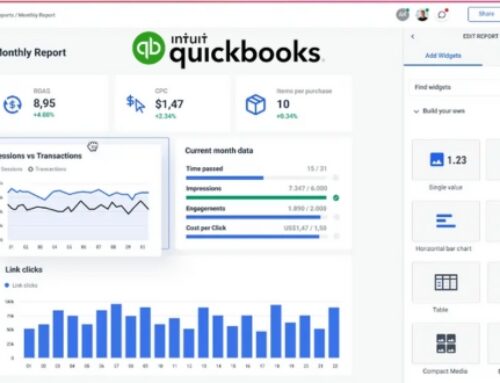Introduction
In today’s fast-paced business world, efficiency is king. Every minute spent on manual tasks is a minute stolen from growth, innovation, and customer satisfaction. But what if you could streamline your workflow, automate tedious processes, and gain deeper insights into your business operations, all within the familiar confines of your beloved QuickBooks? Enter the world of third-party app integrations.
Think of it like this: QuickBooks is your trusty financial fortress, holding all your valuable data. Third-party apps are like specialized tools, each designed to tackle a specific task with unmatched efficiency. By connecting these tools to your financial fortress, you create a powerful ecosystem where data flows seamlessly, tasks execute automatically, and insights emerge from the shadows to guide your every decision.
The Benefits Are Bountiful:

- Say goodbye to manual data entry: Imagine invoices automatically syncing from your e-commerce platform to QuickBooks, or customer information flowing effortlessly between your CRM and accounting software. No more tedious copy-pasting, no more errors, just smooth, automated data transfer that saves you precious time and minimizes human error.
- Boost your efficiency: With repetitive tasks automated, you and your team can focus on what truly matters: driving sales, building relationships, and strategizing for growth. Let the apps handle the mundane while you unleash your creativity and expertise.
- Accuracy becomes your middle name: No more double-checking numbers or reconciling discrepancies. Seamless data integration ensures all your financial information is consistent and up-to-date, giving you a clear and accurate picture of your business health.
- Enhanced customer experience: When your systems talk to each other, your customers reap the benefits. Orders get processed faster, invoices arrive promptly, and support queries are resolved with lightning speed. Happy customers translate to repeat business and loyalty.
- Make informed decisions based on data, not gut feelings: With all your data gathered in one place and presented in insightful reports and dashboards, you can ditch the guesswork and make strategic decisions based on real-time analytics. See where your money is going, identify growth opportunities, and optimize your operations for maximum impact.
Types of Integrations: Finding the Perfect Fit

The world of third-party app integrations is vast and diverse. To find the right tools for your needs, it’s important to understand the different types available:
- Direct API Integration: This offers the highest level of customization and control, but requires technical expertise to set up and manage.
- Connectors: These pre-built connections simplify the integration process for popular apps, making them ideal for non-technical users.
- Zapier: This platform acts like a digital bridge, allowing you to connect hundreds of different apps and automate workflows with ease.
Choosing the right type of integration depends on your technical skills, budget, and the specific apps you want to connect. No matter your needs, there’s an integration solution waiting to transform your QuickBooks experience.
Choosing the Right Apps

Finding Your Perfect App Allies: Choosing the Right Tools to Supercharge Your QuickBooks
With the allure of streamlined workflows and automated tasks dangling before you, the next question arises: which third-party apps are the perfect allies for your QuickBooks fortress? Don’t worry, intrepid explorer, this section will equip you with the tools and knowledge to navigate the vast landscape of app possibilities and choose the ones that perfectly complement your business needs.
Know Thyself: Defining Your Needs
Before diving headfirst into the app pool, take a moment for introspection. What are your biggest business challenges and goals? Do you struggle with managing customer relationships? Is inventory control a constant headache? Are you looking to automate marketing campaigns or boost your e-commerce sales? Identifying your specific needs is the first step in finding the right apps to address them.
Charting the App Galaxy: Exploring Different Categories

Now, let’s explore the diverse constellations of app categories within the QuickBooks ecosystem:
- CRM (Customer Relationship Management): Nurture relationships, track interactions, and close more deals with apps like Salesforce, Zoho CRM, and HubSpot. These apps seamlessly integrate with QuickBooks, eliminating manual data entry and providing a holistic view of your customer journey.
- Marketing Automation: Automate repetitive marketing tasks, manage campaigns, and analyze results with apps like Mailchimp, Constant Contact, and ActiveCampaign. Streamline your email marketing, schedule social media posts, and track leads directly from your QuickBooks dashboard.
- Inventory Management: Keep your stock levels in check, optimize ordering, and prevent stock outs with apps like Inventory Planner, Cin7, and Zoho Inventory. These tools integrate with your QuickBooks data, providing real-time inventory insights and automated purchase orders.
- E-commerce Integrations: Connect your online store to QuickBooks with apps like Shopify, WooCommerce, and BigCommerce. Simplify order processing, manage inventory, and synchronize financial data effortlessly, ensuring a seamless experience for both you and your customers.
- Project Management: Keep your team on track and projects on schedule with apps like Trello, Asana, and Monday.com. These tools integrate with QuickBooks to track project costs, assign tasks, and collaborate with team members in real-time.
Stargazing with Precision: Research and Comparison
Once you’ve identified relevant app categories, it’s time to compare the specific options within each. Here are some key factors to consider:
- Features: Does the app offer the functionalities you need? Does it integrate seamlessly with QuickBooks and your other business tools?
- Pricing: Compare different pricing plans and find one that fits your budget. Many apps offer free trials, allowing you to test-drive before committing.
- User Reviews: Read reviews from other QuickBooks users to get an idea of the app’s ease of use, reliability, and customer support.
- Compatibility: Ensure the app is compatible with your version of QuickBooks and operating system.
Remember, the “best” app is subjective. Choose the one that best aligns with your specific needs, budget, and workflow.
Trial and Error: Testing the Waters
Don’t be afraid to take advantage of free trials and demos offered by many apps. This is your chance to get hands-on experience and see if the app truly lives up to its promises. Test-drive different features, explore the user interface, and connect the app to your QuickBooks account. By putting the app through its paces, you can make an informed decision before investing in a paid plan.
Choosing the right apps requires a thoughtful approach. By understanding your needs, exploring different categories, and carefully comparing options, you can build a team of app allies that will supercharge your QuickBooks experience and propel your business towards new heights.
Setting Up and Managing Integrations
Building Your Fortress Bridge: Connecting, Mapping, and Securing Your QuickBooks App Integrations
Now that you’ve chosen your trusty app allies, it’s time to build the bridge between your QuickBooks fortress and their specialized outposts. This section will guide you through the process of connecting, mapping, customizing, and securing your integrations, ensuring seamless data flow and maximum benefit from your chosen tools.
Connecting the Dots: Step-by-Step App Integration
The exact process for connecting apps can vary depending on the app you choose. However, most integrations follow a similar workflow:
- Find the App Integration: In QuickBooks, navigate to the “Apps” section and search for your chosen app. You may need to install the app first if it’s not already listed.
- Authorize the Connection: Click “Connect” and follow the on-screen instructions. You’ll likely be prompted to log in to your app account and authorize the connection with QuickBooks.
- Map the Data Fields: This crucial step ensures accurate data flow between the app and QuickBooks. Match corresponding data fields from each system, such as “customer name” with “customer name” and “invoice number” with “invoice number.”
- Test and Adjust: Once connected, test the integration by sending some sample data from one system to the other. Make any necessary adjustments to the data mapping if needed.
Troubleshooting Tips: If you encounter any problems while connecting your apps, try the following:
- Refresh the page: Sometimes a simple refresh can fix minor connection issues.
- Check your credentials: Ensure you’re using the correct login information for both QuickBooks and your app.
- Consult the app documentation: Most apps offer detailed documentation with troubleshooting tips specific to QuickBooks integrations.
- Contact customer support: If you’re still stuck, reach out to the app’s customer support team or QuickBooks support for assistance.
Mapping Your Data Flow: Building the Perfect Bridge
Data mapping is the art of aligning corresponding data fields between QuickBooks and your app. This ensures information flows accurately and seamlessly, preventing duplicate entries and inconsistencies. Here are some tips for successful data mapping:
- Start with the basics: Begin by mapping the most essential fields, such as customer names, product names, and transaction amounts.
- Use intuitive names: When choosing mapping names, opt for clear and concise labels that make sense to you and your team.
- Test and refine: Don’t be afraid to adjust your data mapping as needed. Test your integrations regularly and make any necessary changes to ensure accurate data flow.
Automation: Letting Your Tools Do the Heavy Lifting
One of the biggest benefits of app integrations is the ability to automate tasks and workflows. Many apps offer built-in automation features, allowing you to set up triggers for specific events, such as:
- Automatically creating invoices in QuickBooks when a new order is placed in your online store.
- Sending automated email reminders to customers about overdue payments.
- Triggering inventory alerts when stock levels reach a critical threshold.
By leveraging automation, you can free up your time for more strategic tasks and improve the efficiency of your entire business operation.
Securing Your Fortress: User Permissions and Data Safety
With any data integration, security is paramount. Here are some steps you can take to ensure your data remains safe and secure:
- Set user permissions: Grant access to your app integrations only to authorized users and assign appropriate levels of permission (e.g., view, edit, delete).
- Use strong passwords: Choose complex passwords for both QuickBooks and your app accounts and avoid using the same password for multiple accounts.
- Enable two-factor authentication: If available, enable two-factor authentication for added security when logging in to your accounts.
- Monitor activity: Regularly review the activity logs of your app integrations to identify any suspicious activity.
By following these security best practices, you can minimize the risk of data breaches and keep your valuable business information safe.
Connecting, mapping, and securing your app integrations is a crucial step in unlocking their full potential. By following these steps and using the provided tips, you can build a secure and efficient data bridge between your QuickBooks fortress and your chosen app allies, paving the way for streamlined workflows, automated tasks, and deeper insights to drive your business success.
Advanced Integration Techniques
Beyond the Basics: Advanced Techniques to Supercharge Your QuickBooks Integrations
You’ve conquered the fundamentals of connecting and managing your QuickBooks app integrations, but the journey doesn’t end there. Dive deeper with these advanced techniques to unleash the full potential of your data and transform your business operations into a finely-tuned machine.
- Crafting Your Custom Insights: Custom Reporting and Analytics
Think of QuickBooks data as a treasure trove waiting to be unearthed. By combining it with data from your third-party apps, you can create custom reports and dashboards that reveal hidden trends, unveil actionable insights, and guide your decision-making like a seasoned navigator.
- Go Beyond the Standard: Ditch the pre-built reports and craft your own using filters, custom fields, and conditional formatting. Analyze sales trends by product category alongside customer demographics from your CRM, or compare marketing campaign performance across different platforms.
- Drill Down Deeper: Don’t settle for surface-level insights. Leverage pivot tables and custom calculations to delve deeper into your data. Identify profitable customer segments, pinpoint underperforming inventory items, and discover cost-saving opportunities.
- Visualize Your Success: Transform data into visually compelling reports and dashboards. Use charts, graphs, and interactive elements to communicate insights clearly and effectively to stakeholders. Empower your team with data-driven decision-making and foster a culture of data-informed growth.
- Building a Workflow Symphony: Multi-App Integration and Automation
Imagine a world where data seamlessly flows between multiple apps, triggering automated actions and streamlining your workflow like a well-rehearsed orchestra. This is the magic of multi-app integration and automation.
- Connect the Dots: Don’t settle for siloed data. Connect your QuickBooks fortress to multiple app allies, creating complex workflows that automate tasks and eliminate manual data entry.
- Orchestrate the Flow: Set up triggers in one app to initiate actions in another. For instance, a new order in your e-commerce store automatically creates an invoice in QuickBooks and triggers inventory updates.
- Customize Your Symphony: Go beyond pre-built workflows and build your own using tools like Zapier or custom scripting. Automate anything from customer onboarding to expense tracking to marketing campaign execution, saving time and boosting efficiency.
- Forging Your Own Path: API Development and Customization
For the truly adventurous explorers, the world of API development opens doors to endless possibilities. By leveraging the power of APIs (application programming interfaces), you can craft custom integrations that cater to your unique business needs.
- Unleash the Hidden Power: With API development, you can bypass limitations of pre-built integrations and tap into the raw data of your apps. This allows for building highly customized data flows, workflows, and even entirely new applications tailored to your specific requirements.
- Embrace the Challenge: API development requires technical expertise and coding knowledge. If you’re not a coding wizard, consider partnering with a developer or consulting with QuickBooks experts to bring your custom integration vision to life.
- Unlocking Innovation: The potential of API development is limitless. Imagine creating integrations that automatically generate financial forecasts based on real-time sales data, or develop a custom mobile app for on-the-go expense tracking and invoice approvals. The possibilities are endless.
Remember, advanced integration techniques are not just about bells and whistles; they are about unlocking the true power of your data and empowering your business to reach its full potential. Whether you choose to create custom reports, build complex workflows, or delve into API development, these advanced tools will equip you to navigate the ever-evolving landscape of business technology and chart your own course towards success.
Case Studies and Success Stories
Theory is one thing, but witnessing real-world examples of successful integrations can truly ignite imagination and inspire action. So, let’s cast our net into the vast ocean of business stories and reel in some inspiring examples of how QuickBooks integrations have helped businesses conquer challenges and navigate towards success.
Case Study 1: E-commerce Efficiency Booster
Challenge: Acme Gadgets, a growing online retailer, struggled with manual order processing and inventory management, leading to errors, delays, and customer frustration.
Solution: Acme integrated QuickBooks with Shopify, their e-commerce platform. Orders automatically flowed into QuickBooks, triggering invoice creation and inventory updates.
Impact: Integration streamlined order processing, reduced errors by 80%, and freed up staff time for customer service and marketing. Sales increased by 15% within 6 months, thanks to improved efficiency and customer satisfaction.
Case Study 2: Customer Service Champions
Challenge: Bloom & Blossom, a floral boutique, lacked a centralized view of customer interactions, making personalized service and targeted marketing difficult.
Solution: Bloom & Blossom integrated QuickBooks with their CRM software, HubSpot. Customer data from every touchpoint, like phone calls, emails, and online orders, synced seamlessly with QuickBooks.
Impact: With a holistic view of their customers, Bloom & Blossom launched personalized email campaigns that boosted revenue by 20%. They also reduced customer service response times by 35%, leading to higher customer satisfaction scores.
Case Study 3: Inventory Optimization Ace
Challenge: Gear Up Bikes, a cycling equipment retailer, grappled with frequent stockouts and overstocking due to inaccurate inventory forecasting.
Solution: Gear Up Bikes integrated QuickBooks with an inventory management app. Real-time sales data automatically fed into the app, which generated accurate forecasts and optimized purchase orders.
Impact: By implementing dynamic inventory management, Gear Up Bikes reduced stock outs by 75% and minimized overstocked items by 60%. This not only improved customer satisfaction but also freed up valuable cash flow for strategic investments.
These are just a few examples of how QuickBooks integrations can empower businesses of all sizes to overcome challenges, improve efficiency, and drive growth. Remember, the data doesn’t lie. Concrete metrics like increased sales, reduced costs, and improved customer satisfaction paint a clear picture of the tangible benefits these integrations can deliver.
Resources and Support
Your QuickBooks integration journey doesn’t end with the last line of code or the final click of a button. To navigate the inevitable bumps and detours, equip yourself with the right resources and support systems. Consider this section your nautical chart, guiding you to a smooth and successful integration voyage.
Charting Your Course: Essential Resources
- QuickBooks App Store: Your one-stop shop for discovering, exploring, and connecting with thousands of third-party apps tailored to your specific needs. Browse by category, read reviews, and find the perfect app allies to complement your QuickBooks fortress.
- Third-Party App Documentation: Every app comes with its own set of instructions and tutorials. Dive deep into the documentation to understand features, data mapping options, and troubleshooting tips specific to your chosen app.
- Community Forums: Connect with a vibrant community of fellow QuickBooks users and app integrators. Share your experiences, ask questions, and learn from the collective wisdom of others. Popular forums include the QuickBooks Community and the Zapier Community.
- QuickBooks Support: When you’re stuck, don’t hesitate to reach out to the official QuickBooks support team. They offer a wealth of resources, including online guides, tutorials, and live chat support. Don’t be afraid to leverage their expertise to overcome any integration hurdles.
- App Developer Support: Each app has its own dedicated support team. If you’re facing issues specific to a particular app, don’t hesitate to contact their support channel. They’re the experts on their own platforms and can provide tailored assistance.
Weathering the Storms: Troubleshooting Tips
- Start Simple: Don’t try to integrate everything at once. Begin with one or two apps and gradually add more as you gain confidence and familiarity.
- Double-Check Connections: Ensure all app connections are established correctly and securely. Verify login credentials, firewall settings, and API keys.
- Data Mapping Matters: Carefully map data fields between QuickBooks and your apps to avoid errors and inconsistencies. Refer to app documentation and test data flow thoroughly.
- Clear Your Cache: Sometimes, cached data can cause glitches. Try clearing your browser cache and restarting your computer if you encounter unexpected issues.
- Seek Help Early: Don’t struggle alone. If you’re stuck, reach out to app communities, forums, or support channels. Their collective wisdom can save you valuable time and frustration.
Remember, even the most seasoned navigators need assistance sometimes. Don’t hesitate to leverage the resources and support available, whether from QuickBooks, app developers, or the wider community. By equipping yourself with the right tools and knowledge, you can chart a smooth and successful course towards maximizing the potential of your QuickBooks integrations and propelling your business to new heights.
Conclusion
Unleashing Your QuickBooks Potential: Embracing the Power of Integration
Your journey through this guide has unveiled the vast potential hidden within your QuickBooks fortress. You’ve discovered the magic of third-party app allies, learned how to connect and manage integrations with precision, and witnessed real-world examples of businesses transformed by the power of data synergy. Now, as you stand at the helm of your integrated business ecosystem, it’s time to set sail and navigate towards a horizon brimming with growth, efficiency, and success.
Remember, the value of app integrations goes beyond mere automation and streamlined workflows. It’s about:
- Unveiling deeper insights: By combining data from across your digital landscape, you gain a panoramic view of your business, spotting trends, understanding customer behavior, and making informed decisions that propel you forward.
- Empowering your team: Free your team from tedious tasks and empower them to focus on strategic initiatives. Let the apps handle the mundane while your people unleash their creativity and expertise.
- Transforming the customer experience: Seamless integrations ensure smoother interactions, faster responses, and personalized experiences that build loyalty and keep your customers coming back for more.
- Unlocking data-driven growth: Data is your fuel, and integrations are your engine. Analyze, optimize, and adapt based on real-time insights, constantly evolving and thriving in the ever-changing business landscape.
Embracing the power of integration is not just a technological shift; it’s a mindset change. It’s about seeing possibilities, envisioning a future where data flows freely, tasks execute automatically, and insights guide your every decision.
As you venture forth, keep these final thoughts in mind:
- Start small, dream big: Begin with one or two app integrations and gradually build your digital team. As your confidence and knowledge grow, so can the complexity of your ecosystem.
- Embrace continuous learning: The world of technology is constantly evolving. Stay updated on new app options, explore advanced techniques, and never stop learning about the ever-expanding possibilities of digital integrations.
- Seek help and collaborate: Remember, you’re not alone on this journey. Leverage resources like forums, communities, and support channels. Collaborate with fellow explorers, share experiences, and learn from each other’s successes and challenges.
Let this guide be your compass as you navigate the exciting world of QuickBooks app integrations. With courage, a thirst for knowledge, and a willingness to embrace the potential of technology, you can transform your QuickBooks fortress into a dynamic hub of efficiency, insight, and growth. The winds of success are at your back, so set sail and watch your business reach new heights!








